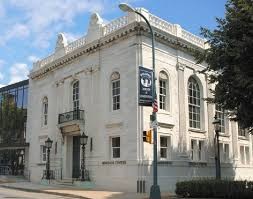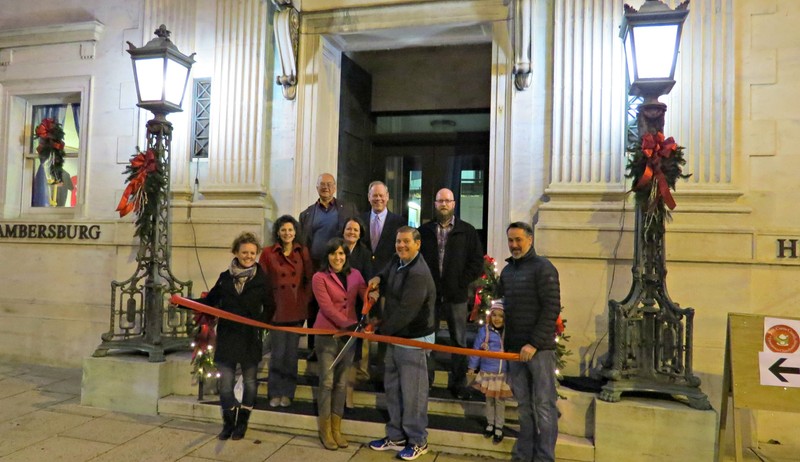Chambersburg Heritage Center and Old Valley National Bank Building
Introduction
Text-to-speech Audio
Images
The former Valley National Bank Building and current Chambersburg Heritage Center. Courtesy of VisitPA.com.

Reopening of the Chambersburg Heritage Center after remodeling completed in 2016.

Backstory and Context
Text-to-speech Audio
Frank Furness, an influential architect in early twentieth-century Philadelphia, designed the building that houses the Chambersburg Heritage Center for the Valley National Bank of Chambersburg. Builders completed the bank’s construction in 1915, three years after Furness’s death. The bank remained in the building until 1963, after which the structure stood vacant until its purchase by the Chambersburg Area Development Corporation in 1999. After five years of planning and renovations, the building reopened its doors under the operation of the Chambersburg Chamber of Commerce, which utilizes the space as a free museum on the history of the Chambersburg area, particularly the period between the colonial and Civil War eras. The museum includes exhibits on the arrival of European settlers to the area in the 1700s, the community’s role in the military conflicts of the eighteenth and nineteenth centuries, its connections to the Underground Railroad, and its destruction at the hands of Confederate raiders in 1864. The center also houses a children’s activity room and gift shop and has, since its opening in 2004, received an average of 3,000 visitors annually (excluding school tours).
Although largely forgotten within a short time after his passing at the age of 72, Frank Furness’s work has garnered increased attention in recent years. Prior to his career as an architect in Philadelphia, Furness served with the 6th Pennsylvania Cavalry during the American Civil War; his service earned him the Medal of Honor in 1899 for carrying ammunition through heavy enemy fire to the relief of a Union outpost during the Battle of Trevilian Station (1864). Furness opened his architectural office in Philadelphia a year after the war ended, going on to receive almost 1,000 commissions (including over 200 train stations for the Baltimore & Ohio and Reading Railroads, University of Pennsylvania Library, and the Pennsylvania Academy of Fine Arts). Furness is also notable for acting as a mentor to architect Louis Sullivan early in his career, who wrote later in his autobiography of Furness’s heavy influence on his work (Sullivan himself, known as the “father of the skyscraper,” acted as mentor to Frank Lloyd Wright).
Because of their relative proximity to its center in Philadelphia, Chambersburg’s wealthier businesses and residents enjoyed a unique level of access to the designers at the forefront of the early twentieth-century’s architectural renaissance. Indeed, prior to designing the Valley National Bank building, Furness had drawn up the plans for Colonel Moorhead Kennedy’s home (known locally as the Ragged Edge). Both structures evidence Furness’s preference for combining an eclectic mix of construction materials into hard rectangular features in defiance of the ornate Victorian style that dominated American architecture in the second half of the nineteenth century. The large rectangular blocks that form the Valley National Bank building’s façade, large, wrought iron-bound windows, and balustraded roof are all reflective of Furness’s chosen aesthetic.
After the Valley National Bank left the building in 1963, it lay vacant for almost over three decades until the Chambersburg Area Development Corporation bought it in 1999. After completing renovations on the building to include modern amenities, the building reopened as the Chambersburg Heritage Center, a museum operated by the Chambersburg Chamber of Commerce that is dedicated to the history of the Chambersburg area from the era of the town’s founding onwards. The museum’s frontier exhibit details the town’s founding by Colonel Benjamin Chambers in 1764 as well as the experiences of early European settlers and the Native groups they encountered. Exhibits related to the Civil War include one on the history of Chambersburg’s role in the Underground Railroad (local legend has it that the Old Franklin County Jail was a stop) and one on the destruction of the town by Confederate raiders in 1864. The center also has exhibits on architecturally significant sites in Franklin County and the history of travel and transportation in the area from wagons to railroads.
Patrons of the Chambersburg Heritage Center can enjoy a visit of dual historical significance. As a museum, the Chambersburg Heritage Center is central to historical education in Chambersburg and Franklin County. But, as an example of Frank Furness’s late work, the building that houses the center deserves equal appreciation. Because Furness’s work was for so long forgotten, city authorities ended up destroying much of it in the urban renewal programs of the mid-twentieth century. The former Valley National Bank building is one of a dwindling number of structures that still bear Furness’s fingerprints, and unlike many of his others remains largely unchanged. Its presence in downtown Chambersburg is a testament to the place of small towns in larger cultural movements within the United States. Architectural enthusiasts visiting Chambersburg will thus find just as much of interest as those who might have more enthusiasm for the past.
The Chambersburg Heritage Center is not only a purveyor of Chambersburg-area history, it is an instrument of its preservation. It has offered its visitors a glimpse into the town’s past both as a museum and as the occupant of an architecturally significant structure since it opened its doors in 2004. Patrons can visit the museum Monday to Friday, 8 AM to 5 PM year-round and on Saturdays, 10 AM to 3 PM, from May to October. They can also schedule guided walking tours of Chambersburg through the Heritage Center upon advance request.
